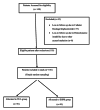A Comparative Study of Erector Spinae Plane Block and Thoracic Epidural Block on Respiratory, Analgesic, and Hemodynamic Outcomes in Patients With Traumatic Rib Fractures
- PMID: 40530210
- PMCID: PMC12171276
- DOI: 10.7759/cureus.84309
A Comparative Study of Erector Spinae Plane Block and Thoracic Epidural Block on Respiratory, Analgesic, and Hemodynamic Outcomes in Patients With Traumatic Rib Fractures
Abstract
Background Rib fractures are associated with significant morbidity and mortality. Thoracic epidural analgesia (TEA) provides excellent pain relief in the management of rib fractures. However, side effects, such as hypotension, and the technical challenges associated with its insertion can limit the use of this technique. Erector spinae plane block (ESPB) is a more superficial ultrasound-guided block, which is easier to perform and does not pose the same risk factors. The primary objective of this study was to compare the analgesic efficacy of continuous TEA and continuous ESPB in patients with traumatic rib fractures, measured by pain scores using the visual analog scale (VAS) and mean opioid consumption, expressed in intravenous morphine equivalents (IME). Secondary objectives included evaluating respiratory and hemodynamic parameters and assessing adverse effects. Materials and methods This was a retrospective cohort study including 100 patients aged 18 years or more with a diagnosis of unilateral multiple rib fractures, who received either continuous TEA or continuous thoracic ESPB as a part of their pain management. Patient data were collected from the medical records of individuals admitted to the emergency department. Groups were assigned later based on the analgesic technique received: Group T (TEA) and Group E (ESPB), with interventions performed according to the institutional protocol. Patients in Group T received TEA in the sitting or lateral position using an 18-gauge Tuohy needle, with a 20-gauge epidural catheter placed for continuous infusion. A primary bolus dose of 15 ml bupivacaine 0.125% was administered, followed by continuous infusion at a rate of 0.1 ml/kg/hour for 48 hours. Patients in Group E received ultrasound-guided ESPB using a low-frequency transducer, with a 20-gauge catheter inserted through an 18-gauge Tuohy needle. A bolus dose of 20 ml of bupivacaine 0.125% was given, followed by continuous infusion at a rate of 0.1 ml/kg/hour for 48 hours. Pain scores using VAS, mean opioid consumption, inspiratory peak volumes as measured with an incentive spirometer, and hemodynamic variables (heart rate, mean arterial pressure, and oxygen saturation (SpO2)) were recorded at baseline (0 hours) and at 3, 6, 12, 24, 36, and 48 hours post-procedure. Results The mean VAS scores were comparable between patients who received thoracic epidural analgesia and those who received ESPB across all time points. Additionally, there was no significant difference between the two groups in terms of mean opioid consumption, mean incentive spirometry volumes, and hemodynamic parameters, including heart rate, mean arterial pressure, and oxygen saturation (SpO₂). Conclusion The study concluded that ESPB appears to be a promising alternative to TEA, offering a simpler and safer approach to analgesia in patients with traumatic rib fractures.
Keywords: erector spinae plane block; mean opioid consumption; rib fracture; thoracic epidural analgesia; visual analog score.
Copyright © 2025, Kumar et al.
Conflict of interest statement
Human subjects: Consent for treatment and open access publication was obtained or waived by all participants in this study. Uttar Pradesh University of Medical Sciences, Saifai, Etawah issued approval 1880/UPUMS/DEAN(M)/2020-21/E. C. NO:148/2020-21. Animal subjects: All authors have confirmed that this study did not involve animal subjects or tissue. Conflicts of interest: In compliance with the ICMJE uniform disclosure form, all authors declare the following: Payment/services info: All authors have declared that no financial support was received from any organization for the submitted work. Financial relationships: All authors have declared that they have no financial relationships at present or within the previous three years with any organizations that might have an interest in the submitted work. Other relationships: All authors have declared that there are no other relationships or activities that could appear to have influenced the submitted work.
Figures
References
-
- Ultrasound-guided fascial plane blocks of the thorax: pectoral I and II, serratus anterior plane, and erector spinae plane blocks. Chin KJ, Pawa A, Forero M, Adhikary S. Adv Anesth. 2019;37:187–205. - PubMed
-
- Improved outcomes associated with the liberal use of thoracic epidural analgesia in patients with rib fractures. Jensen CD, Stark JT, Jacobson LL, Powers JM, Joseph MF, Kinsella-Shaw JM, Denegar CR. Pain Med. 2017;18:1787–1794. - PubMed
-
- The erector spinae plane block: a novel analgesic technique in thoracic neuropathic pain. Forero M, Adhikary SD, Lopez H, Tsui C, Chin KJ. Reg Anesth Pain Med. 2016;41:621–627. - PubMed
LinkOut - more resources
Full Text Sources

